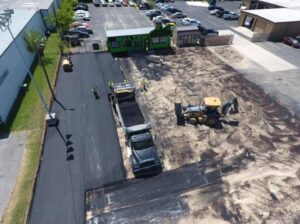 Asphalt pavements have a number of beneficial qualities. They are comparatively economical, strikingly attractive, and fast to construct, maintain, and repair. Furthermore, if you are proactive about maintaining and repairing your pavement, it can have a surprising long life. One aspect of your pavement care that you want to make sure that you do not overlook is your asphalt patchwork.
Asphalt pavements have a number of beneficial qualities. They are comparatively economical, strikingly attractive, and fast to construct, maintain, and repair. Furthermore, if you are proactive about maintaining and repairing your pavement, it can have a surprising long life. One aspect of your pavement care that you want to make sure that you do not overlook is your asphalt patchwork.
Table of Contents
ToggleWhat Is Asphalt Patchwork?
Patchwork is another term for a particular type of asphalt repair known as patching. An asphalt paving contractor in Dallas will probably use patching to repair potholes than to repair any other type of damage. However, asphalt contractors can sometimes use patching techniques to repair alligatored asphalt as well as cracks that are too severe to be repaired using traditional crack repair techniques. Some instances of rutting, edge cracking, fire damage, delamination, and raveling can also be repaired by patching them.
Does Asphalt Patchwork Constitute a Repair or a Maintenance Procedure?
Categorizing procedures can be difficult in any industry, and the line between an asphalt repair and a maintenance procedure is not always sharply drawn. However, although your asphalt company may disagree, most contractors consider patching as a repair. They typically reserve the maintenance category for predictable routine procedures. For example, sealcoating parking lots, repairing most asphalt cracks, and parking lot striping are almost always considered maintenance procedures. These three procedures are considered the most necessary maintenance needs, which is one reason why many sealcoating contractors offer all three services.
How Do Asphalt Contractors Install a Patch?
The type and severity of the damage drives the decision of which patching method a paving contractor in Dallas will use.
1. For damage that is relatively superficial, a surface patch may be all that is required. Surface patches are usually reserved for issues that are limited to the top inch or so of the pavement. These patches are the most inexpensive type, but they do not last very long.
2. Partial-depth patches are a remove-and-replace type of asphalt repair. Asphalt contractors usually saw out squares or rectangles of pavement that are slightly larger than the damage. The depth removed is determined on a case-by-case basis. The contractor will not make any repairs or adjustments to the foundation. After cleaning out the void, the contractor will place and compact a sufficient number of asphalt courses to restore the area to its original height. Partial-depth patches cost more than surface patches, but they last much longer.
3. Full-depth patches vary from partial-depth patches in one significant way, which is that the entire depth of the asphalt is removed. The contractor can access the foundation to make any necessary repairs or alterations. Hot mix asphalt is then installed and compacted so that the elevation of the patch will blend into the surrounding pavement.
HI-TEK Paving can assist you with asphalt repair and maintenance needs. We offer asphalt paving, asphalt overlays, asphalt patching, asphalt crack repair, asphalt sealcoating, parking lot striping, concrete repair and installation, and parking lot maintenance. We serve most towns in the greater Dallas-Fort Worth area, including Plano, Mesquite, and Grand Prairie. We have an impeccable reputation for workmanship, service, and integrity. To request a free quote, email Kevin@HI-TEKPaving.com, submit our online form, or call 214-908-9641.
